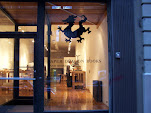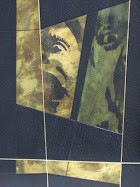



...The boards .......

I use a thin Mill-board , as I`m going to build it up ,
laminating layers of paper , this will help against
warping .
A technique i learned at LCP , that is specifically
designed for this purpose , involves wrapping the boards over the foredge and spine with paper.
(British archival grey..??)
The folding over the spine area will protect against separation when lacing-in , and I`m guessing the action of stretching the paper across both sides of the board give it and added stability.
*nb.we used hot glue to do this , and they dried a lot stiffer compared to the jade I`m using.
To recap , layer of thick paper , either side , then the archival grey.
When ready to mark -up , having frayed-out the cords , I mark a square on the inside of the boards , and get the boards in position , then mark up the board for punching holes , and cutting wedges.You have all done this before , so , nothing new....the cords come back outside to the front of the , where they are frayed out , pasted down , and hammered-out.One thing to not is that it is important to lace the boards on with some breathing space at the joint , I just make a fence , keep it in , take it out when covering , put it back in when setting the joint.
That`s when having steel , or iron-topped board-chopper comes in handy!
When the inside slips , have been pasted and hammered , you are ready to set the square ,
that is put the boards in the final position that they will remain in , so it`s important to get it right *nb...watch the tail , you want your book to stand-up straight , right??also , you can leave the foredge of the boards uncut , and finish them half way through lacing for extra accuracy , but I did mine before .
Thats it , really , a layer of thick cartridge paper after the boards have set overnight in the press , and we are ready for covering.









No comments:
Post a Comment